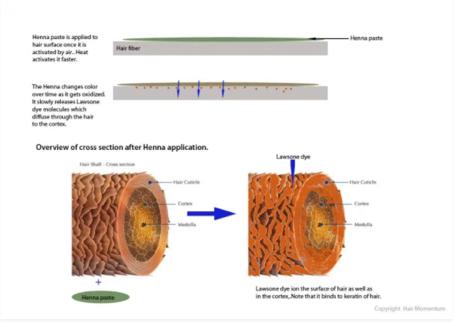You will hear the words henna, “heena”, or “mehndi” used loosely in the marketplace. These terms are sometimes used as catch-all words when people refer to any non-conventional herb or herb mix used as color enhancers for hair or skin. Many of these products are not pure henna, and contain chemical, artificial ingredients or other plant products. In fact some of those products contain only small amounts of henna or no henna at all! So beware. Natural pure henna is lawsonia inermis. Pure henna belongs to the Lythraceae family (a family of flowering plants that includes 620 species). It is the only plant species in the genus Lawsonia. It is a thorny evergreen shrub that can reach up to 6.0 m in height. It has dark green, narrow elliptical and tapering leaves that are approximately 5 cm long and have a tea-like aroma. The fragrant flowers are whitish or pink to brick red and sit in a pyramid-shaped inflorescence. The fruit is a blue-black berry. Henna contains naphthoquinones, most importantly lawson (2-hydroxy-1,4-naphthoquinone), also know as hennotannic acid (1% in the leaves, a little more in the stems and stalks). It is this substance that gives henna its dye properties. Henna also contains tannins (up to 10%), coumarins, flavonoids, phenolic acids, sterols, and xanthones. It is mostly the leaves of the plant that are used as a coloring agent but the bark and the essential oil extracted from the flowers have also been used to some extent. The leaves are usually collected from plants that are about three years old, dried and ground into a powder. The henna paste deposits the lawsone on the outside of the hair cuticles. No lifting or swelling is required. As the lawsone diffuses into the hair, it will bind to the keratin of the hair, and ‘deposit’ the color inside the cortex as well. The color darkens as the lawsone molecules absorb deeper into the hair binding to more protein. The color maxes out in about 48 hours and can naturally last for weeks. When henna powder is first purchased, it will require a process to allow the lawsone to be released which involves exposure to air, a lawsone-release agent, and a moist warm environment. The image below describes how this process works once applied to hair:
What is Henna?


Founder, Botanical Crown
